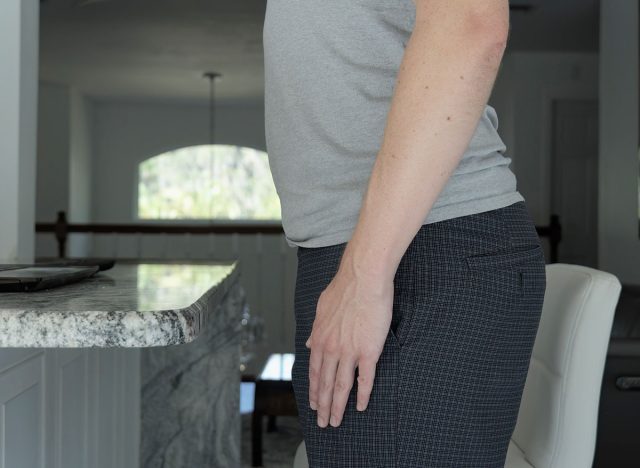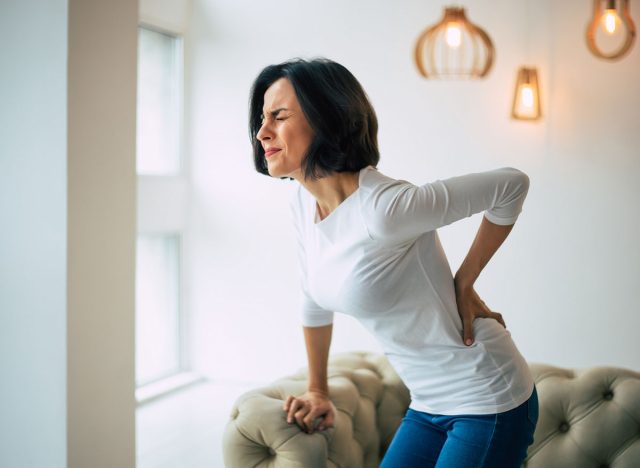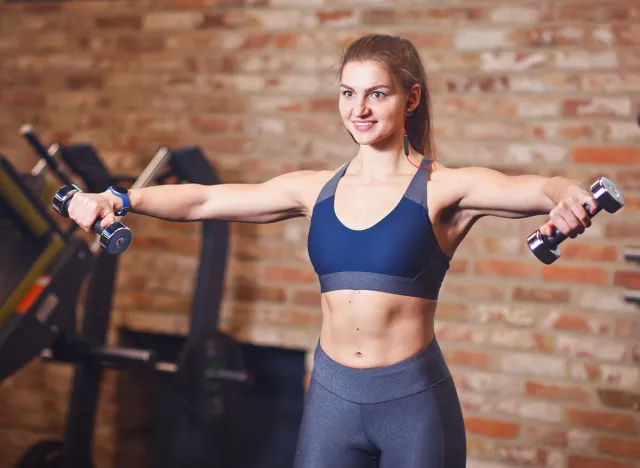5 Posture Mistakes Causing Neck Sagging and How to Fix It

Are you experiencing neck or back pain? It might have to do with your posture. The good news is, once you figure out the mistakes you are making, there are things you can do to correct them, according to Dr. David Tannenbaum, DC, Tannenbaum Chiropractic, Beverly Hills, CA. Here are 5 posture mistakes you might be making and three simple exercises you can do to fix them.
Slouching

Your mother likely scolded you to sit up straight, and she wasn't wrong. "Slouching increases spinal disc load leading to back pain and neck sagging (neck hump). As the static flexion in the neck occurs, the low spinal segments of the neck flare causing neck sagging," explains Dr. Tannenbaum.
Sway Back

The second posture mistake commonly made? "The sway back posture, also known as anterior pelvic tilt, causes increased disc pressure in the low back, which can cause low back pain and weaknesses within the abdominal wall," he says.
RELATED: I Lost 100 Pounds in 6 Months With These 2 Simple Changes
Tech Neck

If you sit in front of a computer all day, you might be feeling it in your back. "Tech neck is known as a position where the person is constantly looking down at a phone or tablet instead of raising their arms with a device at eye level. Constantly looking down at your phone can lead to a sagging neck and strenuous muscular stress in the back of the neck," says Tannenbaum.
Leaning On or Favoring One Leg

Leaning on or favoring one leg can lead to hip and pelvis imbalance which puts stress on the low back, according to Tannenbau. "Constant leaning on one leg can also cause unnatural lateral curvatures leading to pain," he says.
Cradling Your Phone

Cradling your phone in between your shoulders and ears can cause strenuous positions to the muscles of your neck, explains Tannenbaum. "If constantly done, it can also build a lateral shift within your neck structure, putting extra pressure within the cervical discs and leading to pain."
Exercise 1: T's

You can fix your posture in two weeks with these simple exercises and stretches, according to Dr. Tannenbaum. He recommends six to 10 repetitions per exercise and three sets. "These exercises can be done in a prone or standing position with light weights or resistance exercise bandsm" he says. "Exercises are performed by opening up your arms into a prone or standing 'T' position which targets postural muscle between the shoulder blades (rhomboids)."
Exercise 2: Y's

During the "Y" exercises, both arms will come overhead into a "Y" position, targeting the muscles under the shoulder blades (Middle and lower trapezius), he continues.
RELATED: 7 High-Protein Snacks That Support Quick Weight Loss
Exercise 3: I's

During the "I's" exercises, the arm will come straight overhead and target the lower trapezius muscles. "These exercises should be performed daily," he says.
💪🔥Body Booster: What posture mistakes are you making? If you aren't sure, you might want to consult in expert to save you from major damage to your back.




